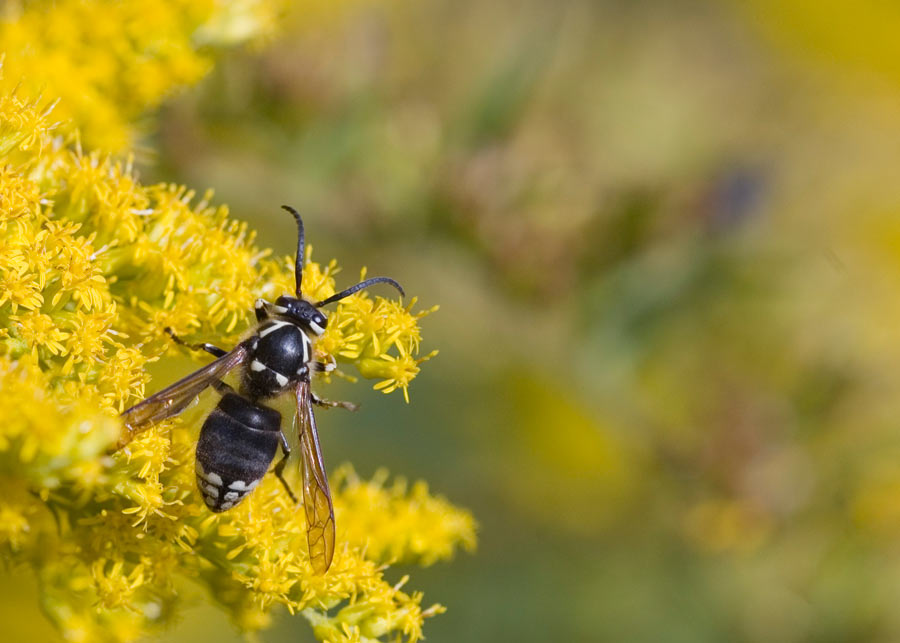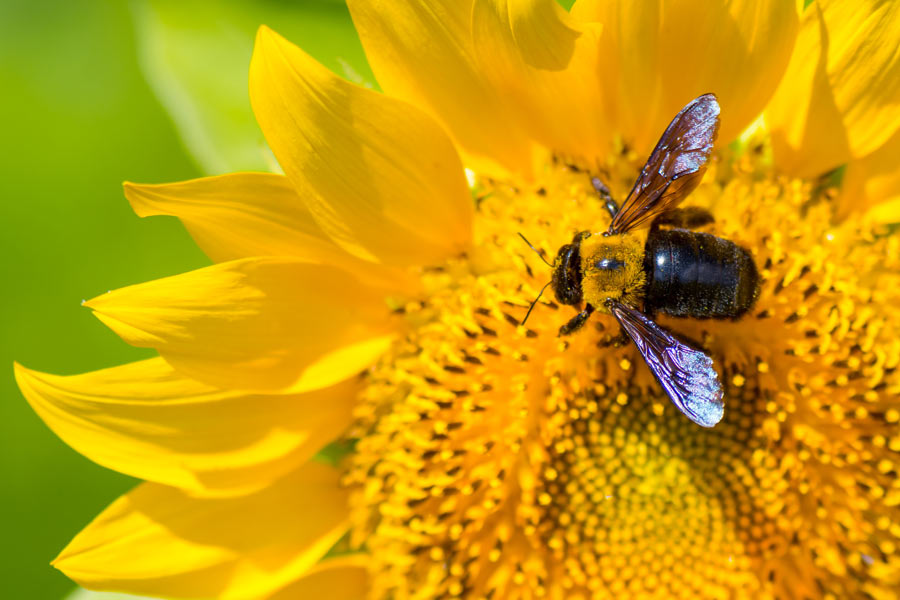HONEYBEE
Beneficial and not particularly aggressive, honeybees nevertheless should be prevented from establishing a nest in your home or structure. Honeybee nests contain wax that will melt and release honey on a structure. This honey will permanently stain walls and will attract numerous more insect pests.
It is quite common for people to confuse Honeybees and wasps. Since Honeybees are extremely important to our ecosystem, we ask that you do not try to treat them yourselves and let us help you identify them so that they can be handled accordingly.


German Yellow Jacket
An invasive, non-native species, the German Yellowjacket is an especially aggressive member of the wasp family. In its native Europe, the species prefers to nest underground, but here in Wisconsin it is commonly found in buildings (attics, wall spaces) as well as in holes in the ground.
Bald-Faced Hornet
This unmistakable member of the wasp family has tell-tale black and white markings and is among the largest stinging pests in Wisconsin. The Bald-Faced Hornet is aggressive and will sting repeatedly if its nest is threatened. The nest, like the hornet, is similarly distinctive; it is an oval football shape commonly found in trees or shrubbery. Nests may also be found under eaves and other protected areas of buildings. To learn more about Bald-Faced Hornet removal, click here.


Paper Wasp
A familiar wasp, the paper wasp is most commonly found around the home (under eaves, deck railings and floors, and porch ceilings). Their nest resembles an open umbrella, and they will sting if it is threatened.
When getting late into the season, you may see large groups of Wasps on your home, they are Paper wasps. Late in the season, they are no longer building nests or trying to enter your home and are therefore much less aggressive. They are just soaking up the warmth of the sun and waiting for mating season to begin. If they are up above 12 feet, we recommend that you just leave them be so that the circle of life can continue for next year. Thank you! Click here to learn more about these wasps.
Carpenter Bee
A nuisance to homeowners not because of the danger they pose to humans but because of the damage they inflict on wood, the carpenter bee should not be allowed to establish an infestation. These bees prefer to bore into the natural wood of a deck or porch. Painted wood may help to deter them, but they have been observed nesting in wood that has only been treated with a stain. Carpenter bees will return to a previous nesting area year after year if not treated, and these multiple generations will do serious damage to your wood structure. Click to learn more about our Carpenter Bee removal services!


MINING BEES
Mining bees are small and dark in color. They will be hovering over the ground near their nesting holes which look like ant hills. They are very docile unless provoked. Each hole is an individual nest with one egg. The mother puts an egg in the hole and then an insect on top of it. Then she closes the hole. That egg will hatch next year, eat the insect, and repeat the process. Click here to learn more about these insects & how we can help prevent them!
BOX ELDER BUGS
Adult box elder bugs are about a ½ inch long, black with orange or red markings, including three strips on the prothorax, the area right behind the head. Their wings lay flat over their bodies, overlapping each other to form an ‘X’. The immature nymphs are 1/16th-inch long and bright red when they first hatch. As they grow older and become larger, they are red and black. You can potentially see all stages at any given time during the summer.
Boxelder bugs are a nuisance in and around homes from fall through early spring. The bug overwinters as an adult in protected places such as houses or other buildings. Removing female Boxelder trees is the most permanent solution to the problem, although this may not be practical or desirable. Click here to learn more about this insect & what to do if you have an infestation!

ASIAN LADY BEETLE

Multicolored Asian lady beetles are extremely common throughout most of the United States and parts of Canada. They prefer the four seasons which makes them extremely popular in Wisconsin. The optimal time to perform the reduction service to stop as many Asian Lady Beetles as possible from entering your home to “overwinter” is in the end of September to beginning of October.
These multicolored little insects are about 7 mm long. Most people think of them as being red but in fact they come in many different colors including yellow and orange. The variability of appearance in the adults can mislead people to think they are a different species.
There are many species of lady bugs in the U.S. and Canada. Most are beneficial insects. They are important to the ecosystems and are plant specialists. They were imported to the United States originally to help control crop pests. The adults and larvae of most lady beetles are predators of aphids, mealybugs, and scale insects. They are usually attracted to lighter color houses and are extremely popular in the fall, and that is the common time to see infestations. As they gather on the house, some find cracks or holes. They use these holes to get inside. Some lady beetles enter quiet places like the attic. They hibernate through the winter and become active again in spring. The larvae may be seen on plants or outdoor surfaces but due to their radically different appearance from the adults, may not be recognized. Click here to learn more about these pests!
BROWN MARMORATED STINK BUG
The brown marmorated stink bug, or simply the Stink Bug, is an insect in the family Pentatomidae, and it is native to China, Japan, Korea and Taiwan. Stink bugs are named for the pungent smell they emit when frightened, disturbed or squashed. They have glands that produce a defensive compound, which has a strong odor that repels predators. It makes them particularly obnoxious.
The fall and the spring are when Stink Bugs are most active. In the fall, they are seeking shelter from the cold weather so they will find any cracks, crevices, or holes to get inside, similar to how Asian lady beetles and Box elder bugs invade houses. And while you may not see them all winter, once the spring season arrives, if you were hosting stink bugs, you will probably find them soaking in rays of sun from a windowsill.
While Stink Bugs do not harm humans or destroy your property, they are unsightly and produce a pungent odor when squashed.
Stink Bugs are relatively new to Wisconsin but have no real predators here. So, you can expect them to get worse and their numbers to increase with the lack of natural predators.
Don’t wait unit you see a lot of them before you call! Your best odds at favorable results is to beat the Stink Bugs to the punch! Click to learn more about these smelly bugs!

